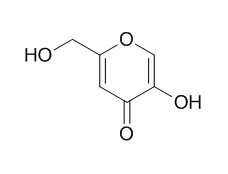Natural Products

- ChemFaces is a professional high-purity natural products manufacturer.
- Product Intended Use
- 1. Reference standards
- 2. Pharmacological research
- 3. Inhibitors




| Size /Price /Stock | 10 mM * 1 mL in DMSO / $9.3 / In-stock | Other Packaging | *Packaging according to customer requirements(100uL/well, 200uL/well and more), and Container use Storage Tube With Screw Cap |

| Size /Price /Stock | 10 mM * 100 uL in DMSO / Inquiry / In-stock 10 mM * 1 mL in DMSO / Inquiry / In-stock | Related Libraries |
| Description: | Kojic acid has been used as a food additive for preventing enzymatic browning of crustaceans and as a cosmetic agent for skin whitening. Kojic acid exhibits concentration-dependent scavenging activity on DPPH possessing strong antioxidant activity, it can reduce the mortality induced by gamma irradiation; it exhibits a competitive inhibition for the oxidation of chlorogenic acid and catechol by potato polyphenol oxidase (PPO) and of 4-methylcatechol and chlorogenic acid by apple PPO; it also has significant tyrosinase inhibitory activity. | |||
| Targets: | Tyrosinase | |||
| In vitro: |
| |||
| In vivo: |
|
| Source: | From the Aspergillus parasiticus. |
| Solvent: | Chloroform, Dichloromethane, Ethyl Acetate, DMSO, Acetone, etc. |
| Storage: | Providing storage is as stated on the product vial and the vial is kept tightly sealed, the product can be stored for up to 24 months(2-8C). Wherever possible, you should prepare and use solutions on the same day. However, if you need to make up stock solutions in advance, we recommend that you store the solution as aliquots in tightly sealed vials at -20C. Generally, these will be useable for up to two weeks. Before use, and prior to opening the vial we recommend that you allow your product to equilibrate to room temperature for at least 1 hour. Need more advice on solubility, usage and handling? Please email to: service@chemfaces.com |
| After receiving: | The packaging of the product may have turned upside down during transportation, resulting in the natural compounds adhering to the neck or cap of the vial. take the vial out of its packaging and gently shake to let the compounds fall to the bottom of the vial. for liquid products, centrifuge at 200-500 RPM to gather the liquid at the bottom of the vial. try to avoid loss or contamination during handling. |
 Cell. 2018 Jan 11;172(1-2):249-261.e12. doi: 10.1016/j.cell.2017.12.019.IF=36.216(2019)
Cell. 2018 Jan 11;172(1-2):249-261.e12. doi: 10.1016/j.cell.2017.12.019.IF=36.216(2019) Cell Metab. 2020 Mar 3;31(3):534-548.e5. doi: 10.1016/j.cmet.2020.01.002.IF=22.415(2019)
Cell Metab. 2020 Mar 3;31(3):534-548.e5. doi: 10.1016/j.cmet.2020.01.002.IF=22.415(2019) Mol Cell. 2017 Nov 16;68(4):673-685.e6. doi: 10.1016/j.molcel.2017.10.022.IF=14.548(2019)
Mol Cell. 2017 Nov 16;68(4):673-685.e6. doi: 10.1016/j.molcel.2017.10.022.IF=14.548(2019)| 1 mg | 5 mg | 10 mg | 20 mg | 25 mg | |
| 1 mM | 7.0368 mL | 35.184 mL | 70.368 mL | 140.736 mL | 175.9201 mL |
| 5 mM | 1.4074 mL | 7.0368 mL | 14.0736 mL | 28.1472 mL | 35.184 mL |
| 10 mM | 0.7037 mL | 3.5184 mL | 7.0368 mL | 14.0736 mL | 17.592 mL |
| 50 mM | 0.1407 mL | 0.7037 mL | 1.4074 mL | 2.8147 mL | 3.5184 mL |
| 100 mM | 0.0704 mL | 0.3518 mL | 0.7037 mL | 1.4074 mL | 1.7592 mL |
| Kinase Assay: |
| ||||||
| Animal Research: |
|